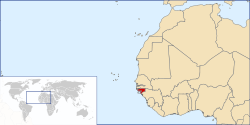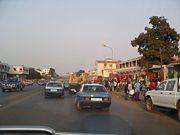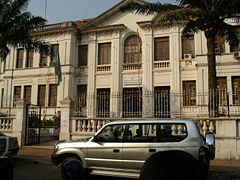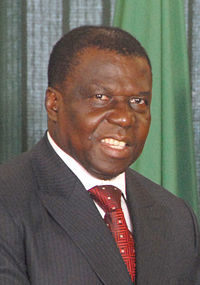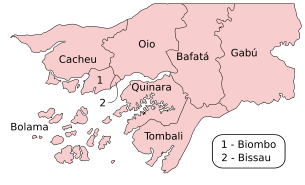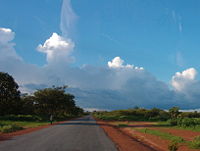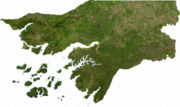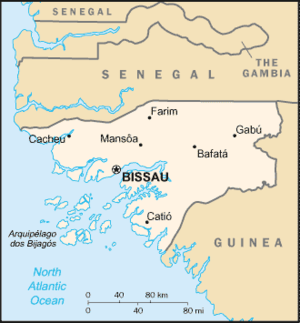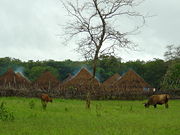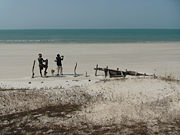Guinea-Bissau
2008/9 Schools Wikipedia Selection. Related subjects: Africa; African Countries
| República da Guiné-Bissau Republic of Guinea-Bissau
|
||||||
|---|---|---|---|---|---|---|
|
||||||
| Motto: "Unidade, Luta, Progresso" (Portuguese) "Unity, Struggle, Progress" |
||||||
| Anthem: Esta é a Nossa Pátria Bem Amada (Portuguese) |
||||||
|
|
||||||
| Capital (and largest city) |
Bissau |
|||||
| Official languages | Portuguese | |||||
| Recognised regional languages | Crioulo | |||||
| Demonym | Guinean | |||||
| Government | Republic | |||||
| - | President | João Bernardo Vieira | ||||
| - | Prime Minister | Martinho Ndafa Kabi | ||||
| Independence | from Portugal | |||||
| - | Declared | September 24, 1973 | ||||
| - | Recognised | September 10, 1974 | ||||
| Area | ||||||
| - | Total | 36,544 km² ( 136th) 13,948 sq mi |
||||
| - | Water (%) | 22.4 | ||||
| Population | ||||||
| - | July 2005 estimate | 1,586,000 ( 148th) | ||||
| - | 2002 census | 1,345,479 | ||||
| - | Density | 44/km² ( 154th) 114/sq mi |
||||
| GDP ( PPP) | 2005 estimate | |||||
| - | Total | $1.167 billion ( 165th) | ||||
| - | Per capita | $736 ( 177th) | ||||
| Gini (1993) | 47 (high) | |||||
| HDI (2007) | ▲ 0.374 (low) ( 175th) | |||||
| Currency | West African CFA franc ( XOF) |
|||||
| Time zone | GMT ( UTC+0) | |||||
| Internet TLD | .gw | |||||
| Calling code | +245 | |||||
The Republic of Guinea-Bissau (pronounced /ˈgɪni bɨˈsaʊ/; Portuguese: República da Guiné-Bissau, IPA: [ʁɛˈpublikɐ dɐ giˈnɛ biˈsau]) is a country in western Africa, and one of the smallest nations in continental Africa. It is bordered by Senegal to the north, and Guinea to the south and east, with the Atlantic Ocean to its west. Formerly the Portuguese colony of Portuguese Guinea, upon independence, the name of its capital, Bissau, was added to the country's name in order to prevent confusion between itself and the Republic of Guinea.
History
Guinea-Bissau was once part of the kingdom of Gabu ( Kaabu), part of the Mali Empire; parts of this kingdom persisted until the eighteenth century. Portuguese Guinea was known also, from its main economic activity, as the Slave Coast. Although the rivers and coast of this area were among the first places colonized by the Portuguese, since the 16th century, the interior was not explored until the nineteenth century. The local African rulers in Guinea, who prospered greatly from the slave trade, had no interest in allowing the Europeans any further inland than the fortified coastal settlements where the trading takes place. The Portuguese presence in Guinea was therefore largely limited to the port of Bissau and Cacheu. For a brief period in the 1790s the British attempt to establish a rival foothold on an offshore island, at Bolama. But by the 19th century the Portuguese were sufficiently secure in Bissau to regard the neighbouring coastline as their own special territory, also up North in part of the present South Senegal.
An armed rebellion beginning in 1956 by the African Party for the Independence of Guinea and Cape Verde (PAIGC) under the leadership of Amílcar Cabral gradually consolidated its hold on the country. Unlike guerilla movements in other Portuguese colonies, the PAIGC rapidly extended its military control over large portions of the country, aided by the jungle-like terrain, its easily-reached borderlines with neighbouring countries and large quantities of arms from Cuba, China, the Soviet Union, and other African countries. Cuba also agreed to supply artillery experts, doctors and technicians. The PAIGC even managed to acquire a significant anti-aircraft capability in order to defend itself against aerial attack. By 1973, the PAIGC was in control of most of the country. Independence was unilaterally declared on September 24, 1973, and was recognized by a 93-7 UN General Assembly vote in November 1973. Recognition became universal following the 1974 socialist-inspired military coup in Portugal.
Following independence local soldiers that fought along with the Portuguese Army against the PAIGC guerrillas were slaughtered by the thousands. A small number escaped to Portugal or to other African nations. The most famous massacre occurred in Bissorã. In 1980 PAIGC admitted in its newspaper "Nó Pintcha" (dated 29/11/1980) that many were executed and buried in unmarked collective graves in the woods of Cumerá, Portogole and Mansabá.
The country was controlled by a revolutionary council until 1984. The first multi-party elections were held in 1994, but an army uprising in 1998 led to the president's ousting and the Guinea-Bissau Civil War. Elections were held again in 2000 and Kumba Ialá was elected president.
In September 2003, a coup took place in which the military arrested Ialá on the charge of being "unable to solve the problems." After being delayed several times, legislative elections were held in March 2004 . A mutiny of military factions in October 2004 resulted in the death of the head of the armed forces, and caused widespread unrest.
In June 2005, presidential elections were held for the first time since the coup that deposed Ialá. Ialá returned as the candidate for the PRS, claiming to be the legitimate president of the country, but the election was won by former president João Bernardo Vieira, deposed in the 1998 coup. Vieira was a candidate for one of the factions of the PAIGC. Vieira beat Malam Bacai Sanhá in a runoff-election, but Sanhá refused initially to concede, claiming that the elections have been fraudulent in two constituencies, including the capital, Bissau.
Despite reports that there had been an influx of arms in the weeks leading up to the election and reports of some "disturbances during campaigning" - including attacks on the presidential palace and the Interior Ministry by as-yet-unidentified gunmen - European monitors labelled the election as "calm and organized".
Politics
Guinea-Bissau is a republic. In the past, the government has been highly centralized and multiparty governance has been in effect since mid-1991. The president is the head of state and the prime minister is the head of government. At the legislative level, there is a unicameral "Assembleia Nacional Popular" (National People's Assembly) made up of 100 members. They are popularly elected from multi-member constituencies to serve a four-year term. At the judicial level, there is a "Supremo Tribunal da Justiça" (Supreme Court) which consists of nine justices appointed by the president. They serve at the pleasure of the president.
João Bernardo "Nino" Vieira became President of Guinea-Bissau in 2005. Vieira returned to power in 2005 after winning the presidential election only six years after being ousted from office during a civil war. Previously, he held power for 19 years after taking power in 1980 in a bloodless coup. In that action, he toppled the government of Luís Cabral.
Regions and sectors
Guinea-Bissau is divided into 8 regions (regiões) and one autonomous sector (sector autónomo). These in turn are subdivided into thirty-seven sectors. The regions are:
* autonomous sector |
|
Geography
At 13,945 sq mi. (36,120 km²), Guinea-Bissau is nearly identical in size to Taiwan, and somewhat larger than the US state of Maryland. This small, tropical country lies at a low altitude; its highest point is 984 feet (300 m). The interior is savanna, and the coastline is swampy plain. Its monsoon-like rainy season alternates with periods of hot, dry harmattan winds blowing from the Sahara. The Bijagos Archipelago extends out to sea.
Major cities
| Cities in Guinea-Bissau | |||||
|---|---|---|---|---|---|
| Rank | City | Population | Region | ||
| 1979 Census | 2005 estimate | ||||
| 1 | Bissau | 109,214 | 388,028 | Bissau | |
| 2 | Bafatá | 13,429 | 22,521 | Bafatá | |
| 3 | Gabú | 7,803 | 14,430 | Gabú | |
| 4 | Bissorã | N/A | 12,688 | Oio | |
| 5 | Bolama | 9,100 | 10,769 | Bolama | |
| 6 | Cacheu | 7,600 | 10,490 | Cacheu | |
| 7 | Bubaque | 8,400 | 9,941 | Bolama | |
| 8 | Catió | 5,170 | 9,898 | Tombali | |
| 9 | Mansôa | 5,390 | 7,821 | Oio | |
| 10 | Buba | N/A | 7,779 | Quinara | |
| 11 | Quebo | N/A | 7,072 | Quinara | |
| 12 | Canchungo | 4,965 | 6,853 | Cacheu | |
| 13 | Farim | 4,468 | 6,792 | Oio | |
| 14 | Quinhámel | N/A | 3,128 | Biombo | |
| 15 | Fulacunda | N/A | 1,327 | Quinara | |
Climate
Guinea-Bissau is warm all year around and there is little temperature fluctuation averaging 26.3 degrees Celsius. The average rainfall for Bissau is 2024 mm although this is almost entirely accounted for during the rainy season which falls between June and September/October. During the months of December, January, February, March and April, the country experiences drought.
Economy
Guinea-Bissau achieved its independence from Portugal in 1974 after a protracted independence war that brought tremendous damages to the country’s economic infrastructure. In 1997, Guinea Bissau's entered the CFA franc monetary system, bringing about some internal monetary stability. The civil war that took place in 1998 and 1999 and a military coup in September 2003 again disrupted economic activity, leaving a substantial part of the economic and social infrastructure in ruins and intensifying the already widespread poverty. Following the parliamentary elections in March 2004 and presidential elections in July 2005, the country is trying to recover from the long period of instability despite a still-fragile political situation.
Guinea-Bissau is one of the world's poorest countries, with more than two-thirds of its population living below the poverty line. The economy depends mainly on agriculture; fishing, cashew nuts and ground nuts are its major exports. A long period of political instability has resulted in depressed economic activity, deteriorating social conditions, and increased macroeconomic imbalances. The key challenges for the country in the period ahead will be to restore fiscal discipline, rebuild public administration, improve the econimical climate for private investment, and promote economic diversification.
In April 2007, UN Office on Drugs and Crime head, Antonio Maria Costa, said he feared Guinea-Bissau could become a "narco-state" following several large cocaine seizures in the country. Sadly, this seems to be occurring as Columbian cartels have used Guinea-Bissau as a transshipment point to Europe in pursuit of the European market for cocaine.
Demographics
The population of Guinea-Bissau is ethnically diverse and has many distinct languages, customs, and social structures. Guinea-Bissauans can be divided into the following three ethnic groups: Fula and the Mandinka-speaking people, who comprise the largest portion of the population and are concentrated in the north and northeast; the Balanta and Papel people, who live in the southern coastal regions; and the Manjaco and Mancanha, who occupy the central and northern coastal areas. Most of the remainder are mestiços of mixed Portuguese and African descent, including a Cape Verdean minority. Portuguese natives comprise a very small percentage of Guinea-Bissauans. This deficit was directly caused by the exodus of Portuguese settlers that took place after Guinea-Bissau gained independence. The country has also a tiny Chinese population, including those of mixed Portuguese and Chinese ancestry from Macau, a former Asian Portuguese colony. Only 14% of the population speaks the official language Portuguese. 44% speak Kriol, a Portuguese-based creole language, and the remainder speaks native African languages. Most Portuguese and Mestiços speak one of the African languages and Kriol as second languages. French is also learned in schools, as the country is surrounded by French-speaking countries and a full member of the Francophonie. Most people are farmers with traditional religious beliefs ( animism); 45% are Muslim, principally the Fula and Mandinka peoples; and fewer than 8% are Christian, mostly Roman Catholics.
Culture
The music of Guinea-Bissau is usually associated with the polyrhythmic gumbe genre, the country's primary musical export. However, civil unrest other factors have combined over the years to keep gumbe, and other genres, out of mainstream audiences, even in generally syncretist African countries.
The calabash is the primary musical instrument of Guinea-Bissau, and is used in extremely swift and rhythmically complex dance music. Lyrics are almost always in Guinea-Bissau Creole, a Portuguese-based creole language, and are often humorous and topical, revolving around current events and controversies, especially AIDS.
The word gumbe is sometimes used generically, to refer to any music of the country, although it most specifically refers to a unique style that fuses about ten of the country's folk music traditions. Tina and tinga are other popular genres, while extent folk traditions include ceremonial music used in funerals, initiations and other rituals, as well as Balanta brosca and kussundé, Mandinga djambadon and the kundere sound of the Bijagos islands.
Matriarchy
In the Bolama archipelago, a matriarchal or matrilineal social system has survived to the present day, although it is currently being eroded by globalization and Christian missionary influence.
In this system, women choose husbands who are compelled to marry them, and religious affairs are controlled by a female priesthood.


